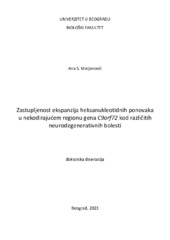Zastupljenost ekspanzija heksanukleotidnih ponovaka u nekodirajućem regionu gena C9orf72 kod različitih neurodegenerativnih bolesti
The prevalence of hexanucleotide repeats expansions in the non-coding region of C9orf72 gene in different neurodegenerative disorders
| dc.contributor.advisor | Novaković, Ivana | |
| dc.contributor.other | Keckarević Marković, Milica | |
| dc.contributor.other | Stefanova, Elka | |
| dc.contributor.other | Stević, Zorica | |
| dc.contributor.other | Keckarević, Dušan | |
| dc.creator | Marjanović, Ana | |
| dc.date.accessioned | 2023-09-06T10:58:46Z | |
| dc.date.available | 2023-09-06T10:58:46Z | |
| dc.date.issued | 2023-07-06 | |
| dc.identifier.uri | https://uvidok.rcub.bg.ac.rs/bitstream/handle/123456789/5315/Referat.pdf | |
| dc.identifier.uri | https://eteze.bg.ac.rs/application/showtheses?thesesId=9235 | |
| dc.identifier.uri | https://fedorabg.bg.ac.rs/fedora/get/o:30696/bdef:Content/download | |
| dc.identifier.uri | https://plus.cobiss.net/cobiss/sr/sr/bib/121684489 | |
| dc.identifier.uri | https://nardus.mpn.gov.rs/handle/123456789/21551 | |
| dc.description.abstract | tkriće ekspanzija heksanukleotidnih GGGGCC ponovaka u nekodirajućem regionu gena C9orf72 predstavlja značajan doprinos rasvetljavanju genetičke osnove amiotrofične lateralne skleroze i frontotemporalne demencije. Godinama unazad, istraţivanja su fokusirana i na otkrivanje njihove potencijalne uloge i u drugim neurodegenerativnim oboljenjima. U ovoj studiji odreĎivana je veličina C9orf72 alela kod nekoliko neurodegenerativnih oboljenja metodama fluorescentnog PCR- a, repeat-primed PCR-a i Southern blot metodom. TakoĎe, dat je prikaz kliničkih parametara kao i njihove korelacije sa veličinom C9orf72 alela. Heterozigotna ekspanzija u genu C9orf72 uočena je kod 31/383 (8,09%) bolesnika sa dijagnozom ALS, 9/129 (6,98%) sa FTD, 2/49 (4,08%) sa atipičnom demencijom i kod 7/22 (31,82%) sa ALS/FTD fenotipom. Ekspanzija nije registrovana kod bolesnika sa bolešću sličnoj Hantingtonovoj bolesti (80 bolesnika), MSA (44 bolesnika), PSP (73 bolesnika), BKP (118 bolesnika), AB (176 bolesnika) kao ni kod zdravih kontrola (96 ispitanika). Ukupno 6 bolesnika su bili nosioci intermedijerne veličine ponovaka na duţem alelu: 1/383 (0,26%) kod ALS, 2/80 (2,5%) kod fenokopije HB, 1/73 (1,37%) kod PSP, 1/129 (0,78%) kod FTD i 1/176 (0,57%) kod bolesnika sa AB kao i kod 3/5 (60%) asimptomatska člana jedne porodice. Jedan ALS nosilac ekspanzije na kraćem alelu imao je intermedijernu veličinu ponovaka dok su ostali nosioci ekspanzije u ALS, FTD i sa atipičnom demencijom imali manje od 20 ponovaka na kraćem alelu. Najveću učestalost u okviru grupe normalnih alela kod svih oboljenja imali su aleli sa 2, 5 i 8 ponovaka. Dobijeni rezultati naglašavaju značaj genetičkog testiranja na prisustvo ove ekspanzije kod bolesnika sa ALS, FTD, ALS/FTD i bolesnika sa atipičnom demencijom sa teritorije Srbije. | sr |
| dc.description.abstract | The discovery of the hexanucleotide GGGGCC repeats expansion in the non-coding region of the C9orf72 gene represents a significant contribution to the genetic basis of amyotrophic lateral sclerosis and frontotemporal dementia. A years back, research is focusing and on discovering their potential role in other neurodegenerative disorders as well. In this study, the size of the C9orf72 allele in different neurodegenerative disorders has been determined with methods of fluorescent PCR, repeat-primed PCR and Southern blot. Also, clinical parameters were described as well as their correlation with C9orf72 allele repeat size. Heterozygous expansion in C9orf72 gene was registered in 31/383 (8,09%) patients with ALS, 9/129 (6,98%) with FTD, 2/49 (4,08%) with atypical dementia, and in 7/22 (31,82%) ALS/FTD phenotype. The expansion was not registered in patients with HD like (80 patients), MSA (44 patients), PSP (73 patients), MCI (118 patients), AB (176 patients) nor in healthy controls (96 respondents). In total, 6 patients were carriers of the intermediate repeats size on the longer allele (1/383 (0,26%) in ALS, 2/80 (2,5%) in HD-like, 1/73 (1,37%) in PSP, 1/129 (0,78%) in FTD, and in 1/176 (0,57%) patients with AD) as well as 3/5 (60%) asymptomatic family members. One ALS expansion carrier on the shorter allele had intermediate repeats, while the rest of the expansion carriers in ALS, FTD, and atypical dementia had less than 20 repeats on the shorter allele. In all examined disorders, the highest frequency of the repeat size in the wild-type range had alleles with 2, 5, and 8 repeats. The obtained results emphasize the significance of genetic testing in patients with ALS, FTD, ALS/FTD, and patients with atypical dementia in Serbia. | en |
| dc.format | application/pdf | |
| dc.language | sr | |
| dc.publisher | Универзитет у Београду, Биолошки факултет | sr |
| dc.rights | openAccess | en |
| dc.rights.uri | https://creativecommons.org/licenses/by-nc-nd/4.0/ | |
| dc.source | Универзитет у Београду | sr |
| dc.subject | GGGGCC | sr |
| dc.subject | GGGGCC | en |
| dc.subject | C9orf72 | en |
| dc.subject | expansion | en |
| dc.subject | amyotrophic lateral sclerosis | en |
| dc.subject | frontotemporal dementia | en |
| dc.subject | ALS/FTD | en |
| dc.subject | atipical dementia | en |
| dc.subject | correlation | en |
| dc.subject | C9orf72 | sr |
| dc.subject | ekspanzija | sr |
| dc.subject | amiotrofična lateralna skleroza | sr |
| dc.subject | frontotemporalna demencija | sr |
| dc.subject | ALS/FTD | sr |
| dc.subject | atipična demencija | sr |
| dc.subject | korelacija | sr |
| dc.title | Zastupljenost ekspanzija heksanukleotidnih ponovaka u nekodirajućem regionu gena C9orf72 kod različitih neurodegenerativnih bolesti | sr |
| dc.title.alternative | The prevalence of hexanucleotide repeats expansions in the non-coding region of C9orf72 gene in different neurodegenerative disorders | en |
| dc.type | doctoralThesis | |
| dc.rights.license | BY-NC-ND | |
| dc.identifier.fulltext | http://nardus.mpn.gov.rs/bitstream/id/151571/Disertacija_13696.pdf | |
| dc.identifier.fulltext | http://nardus.mpn.gov.rs/bitstream/id/152435/Referat.pdf | |
| dc.identifier.rcub | https://hdl.handle.net/21.15107/rcub_nardus_21551 |



